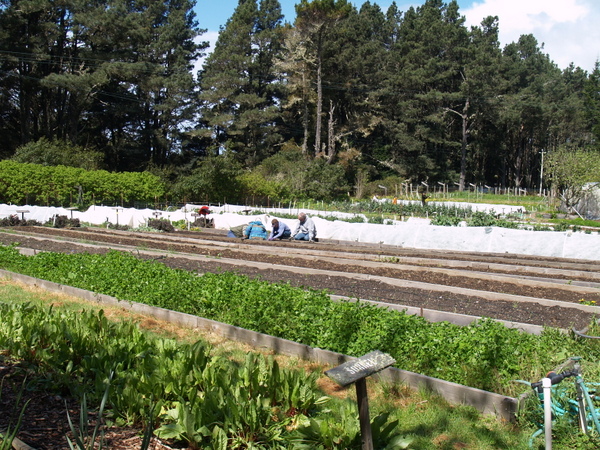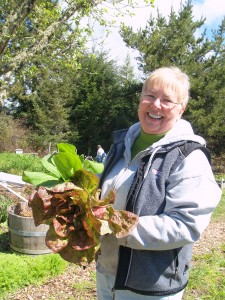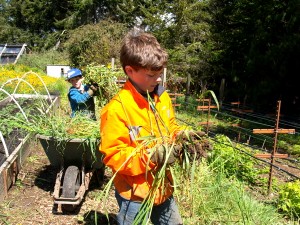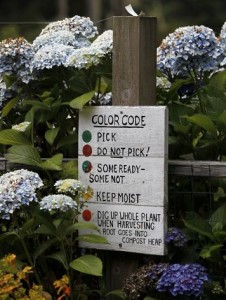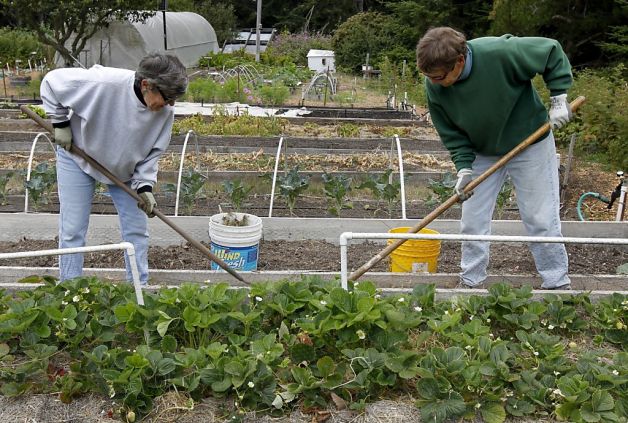
All it takes to enjoy the garden’s abundance is a yearly stipend and three hours a week devoted to the garden. (Photo: Paul Chinn, San Francisco Chronicle)
CALIFORNIA Sonoma County – To a gardener who sticks things in and hopes for the best, a visit to The Sea Ranch’s community garden, the Posh Squash, is a real eye opener. Here, absolutely nothing is left to chance.
The Sea Ranch, planned in the 1970s as a model of environmental sensitivity, is located on a spectacular, twelve-mile stretch of Sonoma County’s most northerly coastline. Today, a population of 1300 full-time and part-time residents, median age 60-plus, continue to uphold the development’s mantra “to live lightly on the land.”
Participants share equally in work and bounty …
Out of that early sensitivity, a community garden developed. But, unlike most community gardens where participants farm individual plots, the Posh Squash, from its first spade turn in 1975, has been one for all and all for one.
Participants, some 100 today, share equally in the work and the bounty. Yearly dues of $125 and a willingness to devote three hours a week is all it takes to open the gate to the garden’s organically grown abundance.
According to Sara McCamant with iGrow Sonoma, an organization that promotes edible gardening, community gardens have sprouted like poppies in spring throughout the county. Of the 60 they keep track of, just 14 garden communally, with those staking out individual plots along with shared space. The Posh Squash remains unique in that it is not only the oldest, continuing operating community garden in the county but is also the sole garden to grow entirely communally.
Efficiency is the key to Posh Squash success …
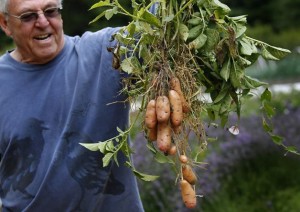
Jim Grenwelge harvests a bunch of Finnish fingerling potatoes. (Photo: Paul Chinn, San Francisco Chronicle)
But what makes the Posh Squash outstanding in its field is its efficiency that rivals, and perhaps surpasses, that of a commercial farm. “We’ve had 37 years to get it right,” Jim Grenwelge, garden chair, says as he leads the way along a hilltop forest trail to the one-acre garden in a leased clearing on the Sea Ranch’s southeast side.
Grenwelge, the Posh Squash’s acknowledged style maven for the signature Bermuda shorts he dons regardless of season or weather, and his wife of now 46 years, Susan, came to the Sea Ranch twelve years ago from Sacramento, following Jim’s retirement from long years in the grocery business and as a partner in a gallery of Native American art. “I immediately gravitated to the garden and stayed,” he says, as he opens the always unlocked garden gate.
A total of 81 beds 50 feet long and 4 feet wide march divided into two orderly rows up a gentle slope. Eighteen are boxed in, with two or three additional raised and filled each year. “We will never raise all the beds,” Grenwelge says, “ as some crops – cucumbers, beans, squash, broccoli, squash – do best at ground level.”
Forest edges the garden on all sides. While the trees offer a wind-buffering barrier, Grenwelge laments the trees’ every-increasing growth that, in a climate that treasures every sunny day, are beginning to cast portions of the garden in shade.
Gardeners share in the work and the planning ….
On this day, a half-dozen gardeners are working in the garden, including Colette Coad, who shares the position of Planting Coordinator. “It’s too big of a job for one!” she sighs with a laugh. Coad and her co-coordinator , Sally Bradley, are responsible for the development of an annual planting plan that includes the ordering of seed, planting activities, and the allocation of beds according to the rotating planting cycle.
Two well-worn books, Chore Book and Planting Book, both developed over the years, help them prioritize weekly chores and the scheduling of greenhouse activities. “Our records and resources continually evolve and change,” Coad says. “For example, we used to collect the date each crop was harvested. Given our climate, there’s so much variability that it proved irrelevant. When the crop is ready, it’s ready.” Successes are documented. Among them, treating aphid infestation. “We observed that if we left the first infested plant in, the aphids rarely move to another in the bed,” she says.
Spread sheets detail the what, when and where …
Spread sheets detail the what, when and where of more than 30 different vegetables and their varieties. Tracked are the number of beds, rows, plants in each bed, whether to seed in the ground or in the greenhouse, planting date, days to maturity and watering method.
Weekly chores often read like recipes: “Put 1 cup liquid fish food (fish emulsion) in a 5 gallon bucket and fill with water. Pour enough solution to wet soil at base of leek plant. One 5 gallon bucket should cover one bed.”
Grenwelge opens the door to the Supply House where the Supply Coordinator, Joyce George, makes certain gardening tools are kept in top-notch condition. On to the greenhouse where the Greenhouse Manager. Linda Warnock, prepares materials for propagation and oversees the Greenhouse Elves as they go about their work.
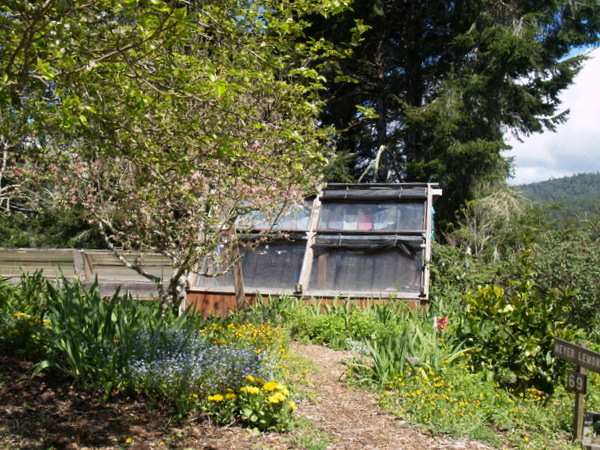
In the greenhouse, the Elves go about the propagation of plant material (Photo: Yvonne Michie Horn).
Composting, too, is highly organized under the direction of Compost King, Chester Kase. “We’re committed to the health of our soil,” he says. “Ever hear of a really good organic garden without a serious compost pile?”
Compost is highly organized, too …
Three “streams” are involved. The fast, for easily compostable materials – gardeners are encouraged to dump in their kitchen trimmings – is frequently tossed and turned for quick use. A second stream, coarser material, is turned less frequently. Twelve bins speed the process with a bin turned every week. “Labor intensive,” Kase says, “but aeration pays off in more heat and a finer product.” The slowest composting material is allowed to simply sit in a heap for a year or so.
On any given day, gardeners may include Posh Squash old hands and those new to getting their fingernails dirty. Sally Skibbons, a founding member, remains involved as the pea lady, keeping track of varieties, ordering, and the starting of seeds. “It’s a wonderful privilege to be here hand and hand with friends and nature,” she says. Newest to the garden are Evan Soly and his wife Lisa, who have found “the Posh” an ideal avenue for becoming acquainted with their neighbors.
Visitors pitch in …
Visitors are welcome to pitch in. On a recent day, two visiting grandchildren of a Posh Squasher pulled weeds and wheeled them away to be composted.
A large part of the garden’s success can be attributed to members who bring with them years of expertise. Bruce Liebrock, Irrigation Guru, is retired from the engineering of irrigation systems internationally for commercial, golf, and agricultural markets. In his nearly 12 years as a Posh Squasher, Liebrock has put the garden completely under drip irrigation, saving an average of 250,000 to 300,000 gallons of water per year.
Mary Hunter knows a lot about vegetables able to thrive in a less than perfect climate; her proficiency gained from backyard gardening in the Northeast along the cool, Canadian border. Hunter is one of 12 gardeners volunteering to become an expert on a specific plant in the garden’s Plant Parenthood program. “I’m the one with the skinny on lettuce,” she says.
Although the Sea Ranch’s climate is ideal for lettuce, Hunter chooses varieties that reach maturity in the shortest time – “So as to keep impatient gardeners from harvesting early,” she laughs. Among garden favorites are Valmaine , “great for Caesar salads”; Drunken Woman, a frizzy headed butter lettuce; and, in the loose leaf category, New Red Fire, maturity in but 29 days.
Color-coded tables indicate when beds, not just lettuce but all produce grown, is available for picking. Red, don’t pick. Green, go ahead. Red and green, pick selectively, ripe fruit only. Green and orange, harvest the entire plant, put trimming in compost bins or piles. Some crops, like garlic, shallots, winter squash, and potatoes are harvest all at once and distributed.
Gardeners are welcome to harvest all they can use …
Gardeners are free to take all they can use , with recipes on the Posh Squash website offering ideas on how to prepare some of the less familiar vegetables such as kohlrabi. Almost all find they must amplify what they pick with a trip to the local supermarket’s produce section, as it is impossible for the garden to provide on any given day a comparable selection of products. “Interestingly, a few gardeners never pick at all,” Grenwelge says. “The pay off for them is the camaraderie of the garden.”
While all beds are always fully planted at least once during the year, some receiving as many as seven rotations, Grenwelge speaks of the challenges of North Coast gardening. “In spring, we often lose several weeks in the first couple of months because of rain. Makes for a slow start!”
Summers lack sufficient heat to grow many crops gardeners would like to grow, such as – melons, eggplant, hot peppers. “On the upside,” Grenwelge continues, “throughout the summer we can continue to grow cooler weather crops including lettuce, broccoli, cabbage and peas.”
Tomatoes were an especially iffy summer crop, given foggy coastal summers until a cloth covered Hoop House, with a solar-generated fan, made gorgeous tomatoes an assured thing.
“ Beefsteak-type did especially well – two-plus pound beauties,” Greenhouse Manager, Linda Warnock reports. “But our most popular is Ananas Noir for its wonderful flavor.”
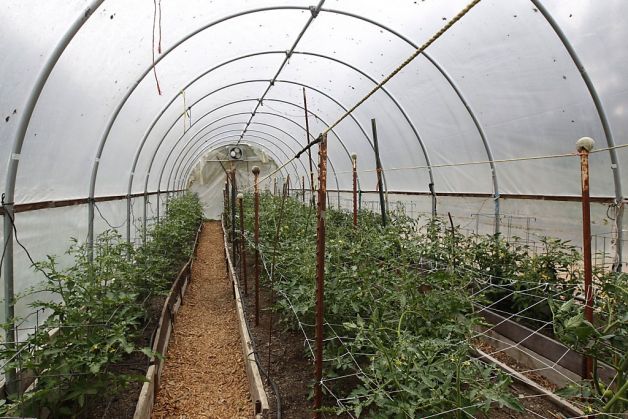
Glorious tomatoes grow in the hoop house. (Photo: Paul, San Francisco Chronicle)
Fall brings the warmest weather to Sea Ranch. “Unfortunately, that’s when we have to start closing the garden down, Grenwelge says. .
Come fall, the garden hunkers down …
Come the end of September, the garden hunkers down for the winter with most beds under an overcoat of “green manure,” cover crops designed to add nutritional and organic material to the soil. Others lie cozily dormant under coats of sheared wool, courtesy of the Sea Ranch’s moveable flocks of sheep in the business of reducing fire hazard through grass munching.
Remaining on the calendar is the annual Harvest Dinner, with gardeners providing Posh Squash inspired dishes. The abundance of the garden is celebrated , but no more so than the good fellowship and friendships enjoyed through the year.

